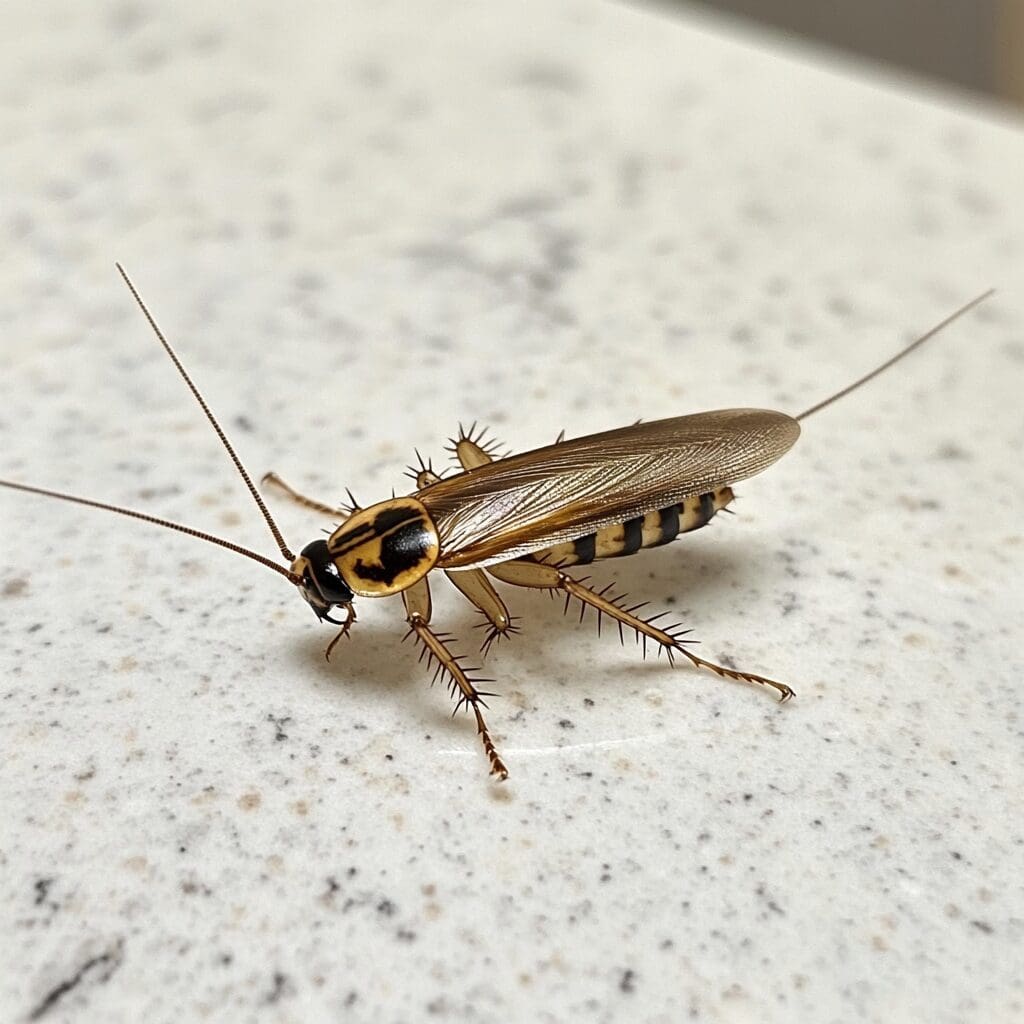
Are you battling a persistent German roach problem in Texas, Louisiana, Mississippi, and Oklahoma in the Southern United States. These resilient pests can be a year-round nuisance, but their activity levels fluctuate with the seasons. Understanding their seasonal cycle is crucial for effective pest control.
In the warm, humid climate of the South, German roaches thrive and reproduce rapidly. While they're active throughout the year, their behavior and population density change as temperatures rise and fall. By learning about these seasonal patterns, you'll be better equipped to tackle infestations and prevent future outbreaks. Let's explore how German roaches adapt to the Southern climate and what you can do to keep them at bay.
German Cockroach Overview in the Southern United States
German cockroaches, scientifically known as Blattella germanica, are small, light brown insects with two dark stripes on their pronotum. They're prolific breeders, adapting exceptionally well to the warm, humid climate of the Southern United States.
In the South, German roaches thrive year-round due to the region's mild winters and extended warm seasons. They're commonly found in:
- Kitchens
- Bathrooms
- Basements
- Crawl spaces
These pests prefer temperatures between 70°F and 80°F (21°C to 27°C), which aligns perfectly with the Southern climate. This optimal environment allows them to reproduce rapidly, with females capable of producing up to 50 offspring every 60 days.
German roaches in the Southern United States exhibit unique behaviors compared to their northern counterparts:
- Increased activity during warmer months
- Higher reproduction rates due to favorable conditions
- More frequent outdoor migrations during peak summer temperatures
The prevalence of German roaches in the South is exacerbated by factors such as:
- Abundant food sources
- Numerous hiding spots in older buildings
- High humidity levels
To combat German roach infestations in the Southern United States, it's crucial to:
- Seal entry points
- Reduce moisture levels
- Eliminate food sources
- Implement regular pest control measures
Understanding the German cockroach's behavior and lifecycle in the Southern climate is essential for effective management and prevention of infestations.
Seasonal Life Cycle
German roaches in the Southern United States exhibit distinct seasonal patterns throughout the year. Their life cycle adapts to the region's warm, humid climate, influencing their behavior and population dynamics.
Spring and Summer Activity
German roaches thrive during spring and summer in the South. Temperatures between 70°F and 90°F accelerate their reproduction rate, resulting in population booms. Female roaches produce 1-2 egg cases every 20-25 days, each containing 30-40 eggs. This rapid breeding leads to exponential growth in infestations during warmer months.
Spring marks increased foraging activity as roaches emerge from winter hiding spots. They seek food and water sources, often venturing outdoors. Summer sees peak activity levels, with roaches becoming more visible in homes and businesses. Higher humidity levels in the South (often exceeding 60%) create ideal conditions for egg development and nymph survival.
Fall and Winter Behavior
As temperatures cool in fall, German roaches begin seeking warmer indoor environments. They congregate in heated structures, concentrating infestations in smaller areas. Winter doesn't induce true hibernation in these pests, but their activity and reproduction slow significantly.
During colder months, roaches cluster in warm, moist areas like kitchens and bathrooms. Their metabolism slows, extending their lifespan. Female roaches may retain egg cases longer, delaying hatching until conditions improve. While less visible, winter infestations remain active, preparing for rapid expansion when spring returns.
Geographic Distribution
German roaches thrive in the warm, humid climate of states like Texas, Louisiana, Mississippi, and Oklahoma in the Southern United States. Their prevalence extends across various states, with specific environmental factors contributing to their success in this region.
Preferred Habitats in Southern States
German roaches in the Texas, Louisiana, Mississippi, and Oklahoma in the Southern United States favor environments that provide warmth, moisture, and easy access to food sources. You'll find these pests concentrated in:
- Urban areas: High-density cities with numerous restaurants, apartments, and office buildings
- Coastal regions: Humid climates near the Gulf of Mexico and Atlantic Ocean
- Older neighborhoods: Homes and buildings with more cracks, crevices, and hiding spots
- Food processing facilities: Warehouses, grocery stores, and restaurants with ample food debris
- Healthcare institutions: Hospitals and nursing homes with constant activity and food availability
These habitats offer ideal conditions for German roaches to reproduce and thrive year-round. The combination of heat, humidity, and human activity in these areas creates a perfect ecosystem for these resilient pests.
| Preferred Habitat | Key Factors |
|---|---|
| Urban areas | High population density, numerous food sources |
| Coastal regions | Elevated humidity levels, consistent warmth |
| Older neighborhoods | More hiding spots, established populations |
| Food processing facilities | Abundant food debris, constant moisture |
| Healthcare institutions | Continuous activity, food availability |
German roaches adapt well to these environments, exploiting the resources and conditions unique to the Southern United States. Their ability to thrive in these habitats contributes significantly to their persistent presence in the region.
Physical Characteristics and Development
German roaches exhibit distinct physical traits and undergo specific developmental stages throughout their lifecycle. These characteristics play a crucial role in their survival and adaptation to various environments in the Southern United States.
Nymph Stages
German roach nymphs progress through six instars before reaching adulthood. Each instar lasts 7-14 days, depending on environmental conditions. Nymphs are wingless, darker in color than adults, and measure 1.5-5 mm in length. They possess two dark, parallel stripes running from head to thorax. Nymphs molt between stages, shedding their exoskeletons to accommodate growth. Their small size allows them to hide in tiny cracks and crevices, making detection challenging.
Adult Roaches
Adult German roaches measure 13-16 mm in length and display a light brown to tan coloration. They have fully developed wings but rarely fly. Two dark, parallel stripes on their pronotum distinguish them from other cockroach species. Adults live 100-200 days, with females producing 4-8 egg capsules during their lifetime. Each capsule contains 30-40 eggs, resulting in rapid population growth. Adult roaches are nocturnal, highly adaptable, and can squeeze through openings as small as 1/16 inch wide.
Factors Affecting Population Growth
The population growth of German roaches in the Southern United States is influenced by several key factors. These elements significantly impact their ability to thrive and reproduce in various environments.
Temperature and Humidity
Temperature and humidity play crucial roles in German roach population dynamics. Warm temperatures accelerate their metabolic rates, leading to faster development and increased reproductive cycles. In the Southern United States, where temperatures often exceed 80°F (26.7°C), German roaches can complete their life cycle in as little as 50-60 days. High humidity levels, typically above 60%, create ideal conditions for egg development and nymph survival. Coastal areas and regions with frequent rainfall provide optimal moisture levels, allowing roach populations to flourish year-round.
Food Availability
Access to food sources directly impacts German roach population growth. These opportunistic feeders consume a wide variety of organic matter, including:
- Human food debris
- Pet food
- Book bindings
- Soap residues
- Toothpaste
In the Southern United States, abundant food sources in kitchens, restaurants, and food processing facilities contribute to rapid population increases. German roaches can survive on minimal food intake, requiring only 0.5 mg of food per day to maintain basic functions. However, when food is plentiful, females produce larger oothecae (egg cases) containing up to 40 eggs each, significantly boosting population growth rates.
Seasonal Reproduction Patterns
German roaches in Texas, Louisiana, Mississippi, and Oklahoma in the Southern United States exhibit distinct seasonal reproduction patterns influenced by environmental conditions. These patterns significantly impact their population dynamics throughout the year.
Peak Breeding Periods
German roaches breed year-round in the Southern United States due to favorable climate conditions. However, their reproduction rates peak during spring and summer months. Warmer temperatures from March to September accelerate egg development and nymph growth, resulting in 3-4 generations per year. During these peak periods, a single female can produce up to 8 egg capsules, each containing 30-40 eggs. This rapid reproduction leads to exponential population growth, with infestations quickly escalating in size and severity.
Temperature Effects on Reproduction
Temperature plays a crucial role in German roach reproduction cycles. Optimal breeding occurs between 75°F and 85°F (24°C to 29°C), temperatures common in Texas, Louisiana, Mississippi, and Oklahoma in the Southern United States. Higher temperatures speed up egg development, reducing incubation time from 28 days at 68°F (20°C) to just 14 days at 86°F (30°C). Nymphs also develop faster in warmer conditions, reaching sexual maturity in 6-7 weeks instead of 8-12 weeks in cooler climates. This accelerated development allows for more generations per year, contributing to larger infestations during summer months.
Humidity Impact on Breeding
Humidity levels significantly affect German roach reproduction in the Southern United States. High humidity, often exceeding 70% in coastal and inland areas, creates ideal breeding conditions. Moist environments prevent egg cases from drying out, increasing hatching rates by up to 95%. Nymphs also thrive in humid conditions, with survival rates 20-30% higher than in drier climates. The combination of high humidity and warm temperatures in Southern states provides nearly perfect conditions for year-round breeding, making population control challenging for homeowners and pest management professionals.
Impact on Homes and Businesses
German cockroaches in the Southern United States significantly affect homes and businesses due to their year-round presence and rapid reproduction rates. Their persistent infestations create numerous challenges for property owners and occupants.
Year-Round Infestations in the South
The warm climate of the Southern United States enables German roaches to thrive throughout the year. Unlike colder regions where cockroach activity slows during winter, southern states experience continuous infestations. This year-round presence leads to:
- Constant pest control needs
- Increased property maintenance costs
- Higher risks of contamination in food service areas
- Persistent health concerns for residents and employees
Businesses in the hospitality and food service industries face particular challenges, as roach sightings can damage reputations and lead to failed health inspections.
Economic Consequences
German roach infestations impose significant economic burdens on homes and businesses:
| Economic Impact | Estimated Cost |
|---|---|
| Annual pest control expenses | $250 - $1000 per property |
| Damage to inventory and equipment | Up to $5000 for severe infestations |
| Lost business due to reputation damage | 15% - 30% revenue decrease |
| Health-related absences | 2-3 days per employee annually |
These costs escalate quickly, especially for businesses dealing with large-scale infestations. Proactive pest management becomes crucial for mitigating these economic impacts.
Health Risks and Sanitation Concerns
German roaches pose serious health risks in infested properties:
- Allergen production triggering asthma and allergies
- Pathogen spread, including Salmonella and E. coli
- Contamination of food preparation surfaces
- Psychological distress for occupants
Businesses face additional sanitation challenges:
- Increased cleaning and sanitization requirements
- Potential for product contamination in retail and food service
- Risk of violating health codes and regulations
Implementing strict sanitation protocols and regular pest inspections helps mitigate these health and sanitation concerns.
Seasonal Prevention and Control Methods
Effective German roach control in the Southern United States requires tailored strategies for each season. Adapting your approach throughout the year maximizes prevention efforts and minimizes infestations.
Spring and Summer Strategies
Spring and summer demand aggressive control measures due to increased roach activity. Implement these strategies:
- Seal entry points: Caulk cracks and crevices around windows, doors, and pipes.
- Reduce moisture: Fix leaky faucets, pipes, and air conditioning units.
- Remove food sources: Store food in airtight containers and clean spills immediately.
- Use baits and traps: Place gel baits and sticky traps in high-traffic roach areas.
- Professional treatments: Schedule quarterly pest control services for thorough inspections and treatments.
- Maintain outdoor areas: Keep grass short, remove leaf litter, and store firewood away from structures.
- Use dehumidifiers: Reduce indoor humidity levels to make environments less hospitable for roaches.
- Exclusion techniques: Weather-strip doors and windows to prevent roaches from seeking warmth indoors.
- Inspect deliveries: Check packages and groceries for roach stowaways before bringing them inside.
- Monitor heating systems: Regularly inspect and clean HVAC systems to reduce warm, humid environments.
- Continue sanitation: Maintain cleanliness standards to limit food and water sources for overwintering roaches.
- Use residual insecticides: Apply long-lasting treatments in potential hibernation spots like wall voids and crawl spaces.
- Implement monitoring systems: Use glue boards and pheromone traps to detect early signs of infestation.
- Educate occupants: Train family members or employees on roach prevention practices specific to colder months.
Climate Change Effects on Seasonal Patterns
Climate change is altering the seasonal patterns of German roaches in Texas, Louisiana, Mississippi, and Oklahoma in the Southern United States. Rising temperatures extend their active periods, leading to longer breeding seasons and increased population growth. Warmer winters reduce die-offs, allowing more roaches to survive and reproduce earlier in the year.
Shifting precipitation patterns affect humidity levels, creating new habitats for German roaches. Increased rainfall in some areas provides more moisture, supporting larger populations. Conversely, drought conditions in other regions concentrate roaches in urban areas with reliable water sources.
Extreme weather events, such as hurricanes and floods, disrupt roach habitats and force them into new areas. This displacement often leads to infestations in previously unaffected locations. Post-disaster cleanup efforts can inadvertently spread roach populations across wider geographic areas.
Climate change impacts on agriculture and urban development influence food availability for German roaches. Changes in crop production and waste management practices alter their food sources, affecting population dynamics and distribution patterns.
Rising temperatures in traditionally cooler regions of the Southern United States create new suitable habitats for German roaches. This expansion of their range increases the likelihood of infestations in areas previously less affected by these pests.
| Climate Change Factor | Effect on German Roaches |
|---|---|
| Temperature Increase | Extended breeding season |
| Warmer Winters | Higher survival rates |
| Altered Precipitation | New habitat creation |
| Extreme Weather | Population displacement |
| Agricultural Changes | Shifting food sources |
Adapting pest control strategies to address these climate-induced changes is crucial. Implementing year-round monitoring systems helps detect shifts in roach activity and population dynamics. Utilizing climate-resilient building materials and designs reduces potential entry points and habitats for roaches in changing environmental conditions.
Collaborating with climate scientists and pest control experts enables the development of predictive models for German roach infestations. These models help anticipate future hotspots and tailor prevention strategies to evolving climate patterns in the Southern United States.
German Cockroach Control - Romex Pest Control
Romex Pest Control offers specialized solutions for German cockroach infestations in the Southern United States. Their comprehensive approach targets the unique challenges posed by these resilient pests, considering regional climate factors and seasonal variations.
Integrated Pest Management
Romex helps you implement an Integrated Pest Management (IPM) strategy, combining multiple control methods:
- Thorough inspections to identify infestation sources
- Targeted treatments using EPA-approved insecticides
- Baiting systems strategically placed in high-activity areas
- Exclusion techniques to seal entry points
- Sanitation recommendations to eliminate food and water sources
Year-Round Monitoring
Romex's pest control experts conduct regular monitoring throughout the year, adapting their strategies to address seasonal fluctuations in German cockroach populations:
- Spring: Increased focus on preventing population explosions
- Summer: Intensified treatments during peak breeding season
- Fall: Proactive measures to prevent indoor migrations
- Winter: Targeted treatments in warm, humid indoor areas
Climate-Adaptive Techniques
Recognizing the impact of climate change on German cockroach behavior, Romex suggests adaptive techniques:
- Use of weather-resistant baits and treatments
- Adjustments to treatment schedules based on local climate data
- Implementation of moisture control methods in humid environments
- Application of heat-tolerant insecticides for prolonged effectiveness
Customer Education
Romex prioritizes customer education as a key component of effective German cockroach control:
- Providing guidance on proper food storage and waste management
- Offering tips for reducing moisture and humidity in homes
- Educating clients on early signs of infestation
- Sharing preventive measures tailored to Southern U.S. climates
By combining expert knowledge, advanced techniques, and customer collaboration, Romex Pest Control delivers effective, long-term solutions for German cockroach infestations in Texas, Louisiana, Mississippi, and Oklahoma in the Southern United States.
Conclusion
German cockroaches present a year-round challenge in the Southern United States. Their adaptability to seasonal changes demands a comprehensive approach to pest control. By understanding their behavior and implementing tailored strategies for each season you'll be better equipped to manage infestations. Remember professional pest control services like Romex offer expert solutions adapted to the unique climate conditions of the South. With the right knowledge and tools you can effectively combat German cockroach infestations ensuring a pest-free environment throughout the year.
We hope you enjoy these informational articles. If you'd like to learn more about our eco-friendly pest control services, call (844) 955-2447.
Read More
Your Path to a Pest-Free Home or Business
Romex Pest Control
We are committed to protecting you, your children, and your pets with our eco-friendly, child-friendly, and pet-friendly guaranteed pest control solutions.
Romex Pest Control is fully insured and licensed in Texas, Oklahoma, Louisiana, and Mississippi.
Service Areas:
Hours
M-F 8 am–5 pm
Sat 8 am–2 pm
Sun Closed
Established 2016 © Copyright 2025 Romex Pest Control










